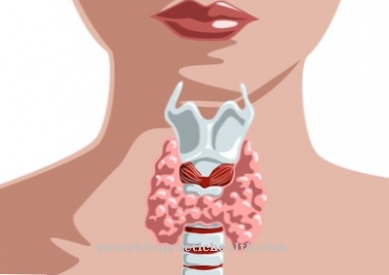The Milk production is a natural process of the female body. Milk is produced in the glandular tissue of the breast and delivered through the nipple. This process will too lactation called and usually runs without complications.
What is milk production?

The glandular tissue of the female breast is designed to secrete breast milk when necessary, which is used to feed infants. Even during pregnancy, the mammary glands change and enlarge under the influence of pregnancy hormones.
As a rule, milk production begins shortly after the child is born. By sucking the newborn on the nipple, lactation is stimulated and the milk is given off. If there are no illnesses, milk production does not stop until the child is weaned.
Function & task
The natural food of an infant is breast milk. This is produced in the mammary glands in his mother's breast. During pregnancy, the glandular tissue is prepared for milk production by the constant level of the hormones estrogen and progestin.
Sometimes a little premilk appears in the last trimester of pregnancy. The actual lactation does not start until two to eight days after the birth. It is triggered by the sudden drop in estrogen and progestin levels. In addition, the pituitary gland produces the lactating hormone prolactin from this point on. The suckling of the child in turn stimulates the formation of oxytocin. This hormone is known as the attachment hormone. It not only promotes the bond between mother and child, but also promotes the regression of the uterus.
Lactation is maintained as long as the child is breastfed. The duration is irrelevant. If there are no health restrictions, a child can be breastfed for several years. However, the amount and composition of breast milk changes with the age of the child. Immediately after birth, the mammary glands form a thick foremilk.
This is also called colostrum. It contains less fat than the later breast milk, but a lot of vitamins, trace elements and, above all, antibodies that are important for the immune defense of the newborn.
The actual milk formation begins with the penetration of milk, which can sometimes be quite painful. Lactation can be further stimulated by frequent positioning of the child. In this way, the amount of milk released can be adapted to the increased nutritional requirements, even during growth phases.
When weaning, the intervals between the individual breastfeeding phases are increased accordingly. This automatically reduces milk production until it comes to a complete standstill after a few weeks or months.
Illnesses & ailments
In general, milk production is a natural process of the maternal body that is completely free of complications. Only the milk ingress at the beginning of lactation can be very uncomfortable and painful. However, these symptoms can be alleviated with simple home remedies.
Most breastfeeding problems have no physical cause, but are based on incorrect information. For example, many women think that they have no or not enough breast milk because milk production does not start immediately after giving birth. However, it is completely normal for the milk to come in up to a week later.
In the further course of breastfeeding there are sometimes phases in which milk production does not seem to be sufficient. However, it can easily be adapted to the child's growing needs if it is put on more often. The correct application technique must be taken into account.
The midwife is the right contact for all problems related to milk production. This also applies if pain occurs regardless of the milk infiltration. Heavy lactation can occasionally cause milk congestion. This manifests itself through sensitivity to touch of the breast, tangible lumps and a general feeling of illness. If left untreated, blocked milk can lead to breast inflammation. Most of the time, however, simple means can be used to resolve a blocked milk condition.Heat can stimulate the flow of milk so that breast milk can be spread out by hand. After laying the child on, it is advisable to cool the breast as this reduces milk production.
If these measures do not help or if the symptoms even worsen, medication is necessary. During this time, you should continue to breastfeed so that there is no unwanted weaning.
In most cases, breastfeeding can also be continued with other diseases affecting mother and child. In this case, however, you should always consult your doctor. This is especially true if the mother has to take medication. Most substances that a breastfeeding mother ingests can also pass into breast milk. Therefore, with some diseases it makes sense to completely or temporarily stop breastfeeding.
If the infant is to be breast-fed again after successful treatment of an illness, lactation must be maintained during the breastfeeding break. For this purpose, the breast milk can be expressed. Pumping can also stimulate milk production when the amount of milk is actually insufficient.
Although lactation is a body function closely related to the birth of a child, milk can occasionally leak out of the nipples even without pregnancy. In rare cases, this is even possible in men. This is usually an indication of the need for medical treatment.
























.jpg)



